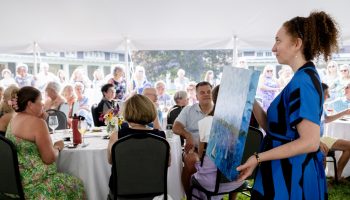Not many new members of the Chautauqua Institution Board of Trustees have had the impact of Jim Klingensmith. Tapped to chair a newly formed Marketing and Communications Committee, he hit the ground running and has maintained his early momentum through a busy summer season. He and his wife Linda live in his family home in the Overlook section of the Institution south of the ravine. We sat on the Klingensmiths’ porch on the latest of what has been an amazing series of beautiful days this year.
Let’s start with your name. Jim or Jamie?
Jim: Up here in Chautauqua, I’m probably known more by Jamie than Jim. The reason is that people I grew up with or knew me as a counselor at Boys’ and Girls’ Club knew me as Jamie. So as I walk down the street, I get Jamie a lot. But professionally, even in high school, I have been known as Jim. I have decided to go in either direction people are comfortable with. I answer to either one.
Linda: I call him Jim, because of when and where I met him. His family calls him Jamie, and my family calls him Jim.
Linda, are you also from a Chautauqua family?
Linda: No. I had never heard of the Institution until I met Jim. I grew up in a little town in Iowa where there was a Chautauqua Park. I knew about the traveling Chautauqua shows.
How did you two meet?
Jim: We met when we were both doing our doctorates at the University of Pittsburgh. I went to a reception for new students, and I wanted to look like a student. I had been chief operating officer at Allegheny General Hospital in Pittsburgh, and I decided I wanted to go back and get a Ph.D. I put on a leisure shirt to fit in with the group. But something you don’t know about me is that I am colorblind. I tend to put on colors that are very bright, and on this occasion I put on a very bright orange shirt. I walk into the reception, and someone said, ‘You really ought to talk to this particular young lady. She’s a year ahead of you and can give you some advice, help you out.’ So I walked over to say hello. My memory is that I was amazed at this person. And on her advice, I dropped out of one class before it even started.
Linda: This particular reception was for both master of business administration and Ph.D. students. Young students seeking their MBA were in their suits and ties; the Ph.D. candidates were more casually attired. Even so, Jim stood out. He stands out anyway because he’s very tall.
Jim: Imagine all this body size in bright orange.
Linda: I had been told a very important person, a chief operating officer at a local hospital, was coming to get their doctorate. So I was kind of looking out for him.
You were both seeking your doctorate.
Jim: Yes, that’s correct. But although Linda started one year ahead of me, she graduated two years before I did. My mother, who was a professor, sent every communication to our home addressed to Dr. and Mr. James Klingensmith as a not-so-subtle reminder for me to get in gear and finish my own Ph.D.
Linda: We were both in the School of Public Health. Jim was more in the administration side of it; I came from a clinical background. I focused on health care policy and program evaluation.
Jim: With my previous experience, my Ph.D. was in strategic management policy, and with a minor in finance. So between us, Linda may look more at the personal side. While I also look at that, I try to see a more strategic side of things.
Linda, you had been in nursing?
Linda: Yes, and later on I went and got my master’s degree and taught at Luther College in northeast Iowa, not far from the Minnesota border. The nursing program there was affiliated with the Mayo Clinic. As juniors, the Luther students would spend a year getting clinical experience at Mayo.
Jim, let’s back up. Where did you go to college?
Jim: I went to Colby College, in Maine. I initially enrolled as an engineering major, in a 3/2 program with MIT: Three years as a math major at Colby, then two in engineering at MIT. That was not for me, and I wound up staying four years at Colby, majoring in economics and finance.
In college, like other young men, I was facing the draft for the Vietnam War. Colby had an Air Force ROTC program, which I joined. I got a deferment after college to get an MBA, then went into the service. I basically went in as what we would call a hospital administrator. After the service, I got a master’s in public health at Pitt, which led me to Allegheny General, where I worked my way up through the ranks.
After getting my Ph.D., I worked at Highmark Blue Cross Blue Shield, based in Pittsburgh. My position there gave me a chance to make a difference in health care and health care delivery.
Linda, how about after your Ph.D.?
Linda: I worked for about four years and we decided to start a family. We have a son and daughter, both thorough Chautauquans. While starting a family, Jim and I launched a consulting business. We had what amounted to a joint practice. After our second child was born, I decided to devote full time to the kids, and did volunteer work, some of it in their schools. I served on a couple of boards.
Did you really get engaged at an Amphitheater concert?
Jim: We were friends at first, two peas in a pod. I was falling in love with this woman, and was scared to death to try to move beyond the friendship stage. I feared risking what I valued so much. But things did progress. Then we visited Chautauqua.
Linda: I thought, whew, an Institution? What is that about?
Jim: I bought a ring, and I had this plan. Linda was here for the weekend. I was going to propose to her on bended knee on the docks in the moonlight. We went to a Dinah Shore concert first.
Linda: The opening act was on stage. Jim had his ubiquitous yellow pad with him. He was always jotting things down that might be useful in his dissertation. We’re sitting there in the choir loft and he’s writing away, and I looked down. He had written, ‘Will you marry me?’
Jim: She didn’t answer right away. I pointed at the written question.
Linda: I wrote, “Are you kidding?” But the answer was yes. Our exchange did attract some attention in the choir loft.
Jim: We did a repeat performance in the moonlight on the docks later that evening.
What were your first Chautauqua impressions?
Linda: It was 1983, a year before (former president Dan) Bratton came. Chautauqua was portrayed as a very relaxed place. I remember being very impressed with the programming. We were just coming up on the weekends.
Jim: I recall that Linda wanted to sample almost everything that Chautauqua offered.
Let’s talk about your board experiences so far.
Jim: I was fortunate to be asked to head up the new Marketing and Communications Committee on the board of trustees. I am also a member of a strategic investments group under the Asset Policy Committee. I see the two as related.
First, on the Marketing and Communications Committee, we have five members, each bringing a different, valuable perspective. Also, since it is a new committee, there’s a blank slate to work with. There’s no template from the past. We form structure around the decision-making process.
I believe you start with an external view. You don’t just look at yourself. I said, “Let’s look at what Chautauqua is and what it does, and look at those same things across the United States.” Take each of the four Chautauqua pillars and look at 20-year trends in those fields across the country. We looked at 74 different points. Then we threw in several case studies. Then we compared Chautauqua’s 20-year trend with the national trends we identified. Key for us was where there were differences. And why? And what did that mean for Chautauqua?
Next was to figure out who comes to Chautauqua. What do they like about it? What don’t they like? And let’s also figure out who doesn’t come here, and what their perspectives might be. The idea is to develop what are called target markets that we can focus on in the future. How do we do that?
I see marketing moving toward promotion, toward advertising. And that is certainly part of it. The part that people sometimes don’t focus on is the research and “product development” piece. But we keep in mind the danger of a process like this: You can forget who you are and lose your values. You wind up being driven by the numbers. That can be dangerous.
I believe [the staff and trustees] have continually been factoring in the vision and values of Chautauqua as we navigate through the process. When the new president takes office, I think we should be in the position of having done the analysis. Then the new president can put his or her stamp on it.
It’s been very hard work, and it’s not done. But I will say it has been fun.
You know, my mother was on the board of trustees, I think from 1977 to 1982. Once in a while, she and I discuss board service then compared with now. One of things that is different is that we are so much more analytical now than 35 years ago. I believe we are more analytical than we were even five years ago.
The other thing to note about our board work is that we are going to [encourage the staff to] experiment. We are enhancing the Friday night Amp specials. We are bringing in a CLSC speaker like David McCullough to the Amp at a non-standard time slot. There is Week Nine, with the jazz.
We’re not asserting that we know all the answers. We don’t. But I believe that if you try things out and are willing to learn from them, you will find your way to some answers.
Are you getting pushback?
Jim: As a long-time Chautauquan, as we proceed, I have often asked myself, “Is this the right thing to do?” So I push back against myself sometimes. But overall, I have been amazed at how people have been willing to listen and think differently about things. I think if you put things in the context of an experiment, people may say, “We haven’t done it that way before, but could try it — as an experiment.” That attitude is extremely encouraging.
Were you surprised at how much work you signed up for when you joined the board?
Jim: I think I have been on nearly 30 boards in my life. I thought I had a pretty good fix on what it would be like to be on the Chautauqua [Institution] Board of Trustees. I was wrong. I have never in my life seen a board work as hard as this one does. Off-season, some board members are spending one or two days a week on Chautauqua. And this is a large board, with 24 people. They are all passionate and have diverse views. The result is a process probably less efficient than you’d see in a corporation, but I think the process and decisions reflect Chautauqua values. Lastly, I thought I understood Chautauqua when I joined the board. I did not. The complexity of the operation here is amazing. Think of the breadth of activity, compressed into the time it happens, and doing it all mostly seamlessly. It gives you an appreciation for what it means to govern this place.
Tell me about your initiatives with the Chautauqua Property Owners Association.
Jim: As you know, I am a Class B trustee, so I am part of the CPOA board. I thought it would be good to get a sense of where property owners stand on some issues that affect them. For instance, should the new construction road near Heinz Beach on South Lake Drive be retained? How about the speed bumps near the police station on Massey? We’ll do some surveying around issues like those.
Linda, what are your special Chautauqua passions?
Linda: Well, I have been drawn to the CLSC. I started doing their [Literary Arts Center at] Alumni Hall docent tours around 20 years ago. I got very involved when some of the class banners were being researched and some of them wound up being transferred to the Oliver Archives. I felt like I was a CLSC employee at times! I’m still involved, though at a less frenetic pace.
Jim: Let me just say that Linda also spent lots of time here with the kids in the summer when they were growing up. I was working in Pittsburgh and did the weekend commuting.
Linda: Since we’re not too far from Club, this house was very popular. Now, our son is in graduate school at Stanford; he gets back when he can. Our daughter is in New Haven, Connecticut and manages to visit a couple of times a year.
(Photo by Sarah Holm.)





